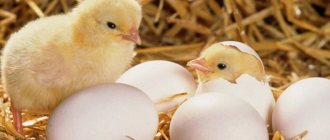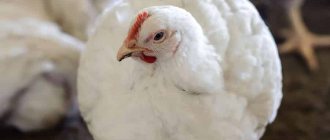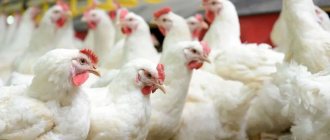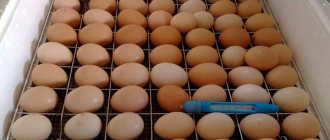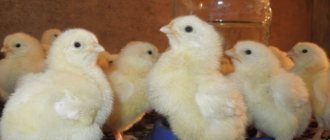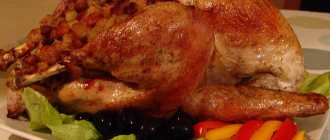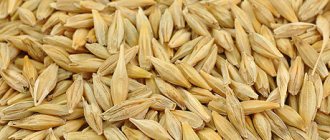Chickens are raised on large farms or at home to obtain large quantities of meat products or eggs. If the main purpose of breeding is financial profit from the sale of these products, it is necessary to select the most profitable chicken breeds for the farmer. Thus, the constant development of poultry farming, as well as competition in the market, became the main reason for the emergence of crosses (crossed breeds). Some of the most popular cross-breed birds are COBB and ROSS broilers.
Broilers COBB and ROSS
It was these breeds that showed the highest results in terms of survival and rapid weight gain. Choosing such a breed allows you to place bets on future offspring based on the initial data.
Which cross is better
Long-term debates among poultry farmers about the best breed for growing are constantly “fueled” by new facts about the benefits of breeding certain cross-breed broilers. Thus, ROSS 708 is valued for its highest carcass weight, as well as its speed of gain (this cross is considered the most profitable). Other broiler crosses are more productive. One of these is ROSS 308. It has a more modest weight, but high egg production. In addition, such birds tolerate incubation rearing well.
Broilers ROSS 308 and 708 have another competitor - the COBB 500 breed.
Numerous reviews from farmers about the intensive growth of COBB broilers are not inferior in number to representatives of any other breed, such as PM3. In addition, the cross gains its weight of 2.2-2.5 kg by 35-40 days, if there is proper and regular feeding. But such chickens have one important difference: a large breast (the most valuable part of the carcass). 308 or 708 ROSS, although they are tall crosses, do not have this feature, so every novice poultry farmer needs to decide on the exact purpose of his activity before buying chickens. You should also know that each cross has its own nuances in its content.
Where to buy broiler chicks
There are many advertisements on AVITO, where private owners offer various chickens that they allegedly bred in their incubator.
Do not buy under any circumstances!
Firstly, sellers may turn out to be unscrupulous resellers. They operate according to what scheme: they take weak chicks that are subject to culling for free from a poultry farm. They advertise for sale and sell to inexperienced summer residents.
Imagine your disappointment! Of the twenty to thirty chicks purchased, one or two will remain! And I feel sorry for them, but they leave several times every day...
And secondly, there are honest sellers who actually sell surplus chicks from their incubator. But! An infection may be smoldering on their farm, to which their adult chickens are accustomed.
And you, having bought infected chickens from them, will bring this infection home to your farm. The chickens can survive, you will treat them, but that’s another story... In general, I think that you should not treat them, but take the chickens back.
Have I convinced you? Then we buy chicks from a trusted farm that was recommended to you by your friends.
The best thing is if it is a farm that specializes only in incubation and complies with all the rules and regulations.
You can buy chicks from a poultry farm that sells surplus. Experienced poultry farmers (I won’t write: summer residents) do just that.
Beginning poultry farmers often ask the question: should I buy day-old chicks or grown ones? My answer is this: if you decide to breed broilers at home for the first time, then buy 30 grown-up, ten-day-old ones. This will make it easier to learn how to raise broilers.
Buy a daily allowance for the second time. You can raise broilers twice in one summer! And you can grow it all year round if you provide cleanliness, the required temperature and adequate ventilation.
Chicks are sold all year round.
Why is ROSS 708 so popular among farmers?
The main goal of every poultry farmer is to obtain maximum profit from the productivity of the bird or from its weight. Broilers ROSS 708 are the most popular among farmers. A key factor in this is the bird's high growth rate. Chickens can gain weight up to 2.9 kg in just 35 days. But novice poultry farmers should also be aware that ROSS 708 is easily confused with some other breeds due to external similarity, so broilers should be selected only from trusted suppliers. You can also watch a VIDEO on how not to make a mistake when choosing this cross.
In addition to their heavy weight, ROSS 708 broilers are characterized by:
- low cost of meat;
- size and power of legs;
- weighty white breast.
Keeping such a breed of birds is beneficial both from the point of view of a high percentage of brood survival and from the point of view of rapid growth. If we talk about the value (and, accordingly, the price) of such chicken meat, taking into account the rapid weight gain, such a breed is financially beneficial for farming.
If you choose this particular breed, it is important to remember the standards for keeping such birds. The health and growth of the breed directly depend on how high their quality of life, care, nutrition, etc. are.
Maintenance and feeding of ROSS 708
The best results from breeding birds for meat are achieved by following certain poultry care features. These include:
- Correct choice of premises for maintenance. Dry, well-ventilated chicken coops are suitable for these purposes.
- Disinfection. This procedure is necessary to avoid the risk of chickens becoming infected with various diseases that can reduce growth rates and even lead to death.
- Insulation of the floor in the chicken coop. For this purpose, hay and sawdust are used.
- Maintaining temperature conditions. Raising poultry requires control of the air temperature in the coop. For this breed, a temperature of 28-32°C is the most favorable indicator for active growth.
- The need to equip the chicken coop with lighting fixtures.
The ROSS 708 broiler breed also requires the fulfillment of certain requirements for the organization of housing space. From the first days of life, chickens can be kept in cages, but by the age of ten days it is necessary to expand the space; the bird must be transferred to a chicken coop, where it will remain until it gains full weight.
Broilers of this cross also require knowledge about the peculiarities of their diet. Like all meat breeds, the daily menu of chickens consists of dry and wet food, consisting of proteins, fats and carbohydrates. We must not forget about vitamins and minerals. Experienced farmers advise purchasing chickens that are already ten days old to avoid nutritional mistakes. If this fails, the novice poultry farmer should:
- Provide chickens with free access to the feeder and drinker. Raw water cannot be poured. Decoctions of rosehip or chamomile should be used.
- In the first days of life, give the bird soft food, which includes a boiled egg, cottage cheese and oatmeal. From the 3rd day of life, chickens also eat ground oatmeal.
- Gradually introduce crushed grain, chalk and shells into the diet, starting from day 10. You can also add boiled potatoes and carrots to your food.
Why broilers gain weight quickly
Those poultry farmers who want to make maximum profit from poultry breeding need to:
- Know about the nuances of keeping birds from the first days of life, which relate not only to equipping the chicken coop with drinkers and feeders, but also to calculating the daily feed requirement.
- Create a temperature regime favorable for poultry breeding (up to 24°C) with an air humidity of no more than 50%.
- Regularly disinfect the chicken coop to prevent chickens from becoming infected with infectious diseases.
Feeding birds also has its own characteristics. Day-old chicks should be fed 8 times a day. On day 5 - 7 times. Broilers are not picky about food, but at the same time they require quality feed.
They readily eat mash of potatoes, carrots, dairy products and crushed grains. All vegetables are suitable, except beets, which have a negative effect on the digestive tract of birds.
If you breed ROSS 308
Meat and egg cross breeds do not always satisfy the needs of farmers, because some poultry farmers want to receive both meat and eggs. Broiler crosses have a narrow focus on producing only 1 of 2 products. Anyone who wants to find a “balance” needs to pay attention to a cross that is popular among farmers: ROSS 308. These chickens are raised not only for meat products, but also for the purpose of producing eggs. But in order to get maximum profit from one and the other, you should know about the features of caring for birds.
If all the nuances are taken into account, the following advantages will be noticeable:
- high performance;
- large mass of carcasses;
- active growth.
Not a single broiler cross can boast such a “balanced” description. However, according to some calculations by experts, this breed is inferior to representatives of COBB in terms of feed conversion and more economical maintenance costs.
In terms of egg production, cross-country chicken is not inferior even to the “Rodonit” breed. Cross-laying hens even surpass their opponents in terms of productive period.
Broiler chickens are in great demand among farmers as they gain weight quickly. The constant development of poultry farming and fierce competition in the market contributed to the emergence of crossed breeds. Broilers Cobb 500 and Ross 308, what is the difference between them - you will get the answer to this question after reading this article.
Cobb and Ross broilers - these breeds have been leading the farmer's market for several years
Nutritional Features
Broilers of this breed need to be fed in a special way. During the first days of life after birth, nutrition is practically no different from feeding ordinary chickens. Most often during this period, a small chicken should be given:
- chopped oatmeal;
- boiled eggs;
- millet;
- wheat and barley, which must be crushed;
- cottage cheese.
Read also: Gilyan breed of chickens: description, photos, characteristics
The basis of the daily diet of children should be crushed grain. After the third day of life, professionals recommend starting to add green food, in particular sprouted grains and vegetables (carrots, cabbage, beets). A week after birth, they begin to gradually introduce potatoes and fish waste into the diet.
For better quality meat, it is recommended to add chalk to food in at least minimal quantities. On the twentieth day, the food can be the most varied, and in the 4th week the hybrid gains the greatest weight, so nutrition during this period should be correct and include fermented milk products. And, of course, don’t forget about water. Raw water is completely contraindicated for them; it is best to use decoctions of chamomile and rose hips.
By purchasing the offspring of this chicken hybrid, your home will always have high-quality meat and eggs, since this bird produces a huge amount of production.
Comparison of Cobb and Ross broiler crosses
It is these broiler breeds that have held the leadership position at the farmers market for several years. So Ross 308 birds have enormous potential: weight gain per day should be from 52 to 58 grams. Their powerful muscle mass is formed at an early age. When they are approximately 8 weeks old, they are slaughtered. During this period, the weight of the carcass averages 2 kg.
What can you say about Cobb 500 broilers? What is the difference between these crosses? The yellow tint of the carcass is the main difference between these broilers. The total carcass weight per month is 2 kg. All over the world, these representatives of birds are in deserved demand, due to the speed of their development and the rapid gain of muscle mass.
Which cross is better - Cobb 500 or Ross 308? It’s impossible to say for sure. After all, each of them has its own characteristics and advantages, so breeders should choose a breed based on their preferences. Next, we will consider these key aspects in detail, photos of crosses, which will make it easier for farmers to make an informed choice.
We invite you to find out which cross is better - Cobb 500 or Ross 308
In conclusion
A special feature of growing the Ross-500 chicken breed is the creation of suitable conditions in the poultry house. Birds of this species love warmth, light and average air humidity. A distinctive feature of the variety is rapid weight gain. However, the color of the fillet does not have time to acquire an appetizing yellowness. If this nuance does not stop poultry farmers, then breeding Ross-500 will bring tangible financial profit.
Broiler chickens are in great demand among farmers as they gain weight quickly. The constant development of poultry farming and fierce competition in the market contributed to the emergence of crossed breeds. Broilers Cobb 500 and Ross 308, what is the difference between them - you will get the answer to this question after reading this article.
Cobb and Ross broilers - these breeds have been leading the farmer's market for several years
Broilers Cobb 500 and Ross 308: what is the difference, photo
Reviews about representatives of these birds are mostly positive. True, the conditions for raising and keeping chickens are somewhat different. Now let's look at the difference between these two crosses. In the photo you can see what their exterior is like.
Characteristics of Cobb 500 broilers:
- large and beautiful breasts;
- strong paws;
- homogeneity of individuals;
- excellent feed conversion rates;
- broiler survival rate – 98%;
- low cost of meat products.
Of course, in order to decide which cross to choose, you need to understand the features of the Ross 308. What is the difference between these birds? Pay attention to the main aspects:
- early readiness for slaughter of broilers;
- stable performance indicators;
- active growth of birds;
- bright skin;
- meat yield when cutting is 74;
- the need for a balanced diet;
- low immunity.
When choosing this or that cross, rely on your own preferences. Thus, Ross birds are universal birds; they are characterized by optimal feed consumption and weight gain. Broilers Cobb 500 are representatives of exclusively meat production, hybrids. It is worth remembering that this poultry will not please the breeder with a large number of eggs.
Broilers Cobb 500 and Ross 308, video:
Many poultry farmers are interested in Cobb 500 and Ross 308 broilers, what is the difference between these birds. These differences are not always visible in the photo. Therefore, the advice from the article, video, and reviews will be especially useful to those farmers who want to raise these chickens in their backyard.
Many farmers breed chickens not for their egg production, but for the sake of obtaining tasty, lean dietary meat from this poultry. For this, it is most profitable to raise broiler chickens.
What is the difference between a cross breed and a breed of chickens?
Crosses
are a hybrid of several breeds or populations. The process of creating a cross is called crossbreeding. The creation of such hybrids is carried out only in industrial production by qualified livestock specialists. This is impossible at home.
When raising cross-breeding chickens, it is not customary to produce offspring from them, since the eggs will produce chickens with the properties of one of the chicken breeds that took part in the cross-breeding.
Broiler chickens. This is a cross, not a breed.
Crosses are created for outstanding performance either in weight or in the number of eggs. Hence: there are egg crosses of chickens, and there are meat crosses of chickens. The photo shows a meat cross, about three weeks old. It is distinguished by a powerful chest and widely spaced paws.
The properties of the cross will be lost during home breeding. Broiler eggs will not produce chicks that quickly gain weight.
Pedigree chickens
represent individual lines with certain qualities, which are constantly cultivated in breeding farms and farmsteads. When chickens of the same breed are crossed with each other, they produce chickens with the original characteristics, that is, the same as the parents.
This breed is called Meroved. Photo from the Internet
In private farms, breeding chickens are bred with a constant “infusion of new blood.” Every year or two, breeders purchase a new rooster from a breeding farm, or hatch new hens and roosters from eggs purchased from the gene pool.
When crossing chickens of different breeds, what happens? Right! Backyard mongrel chickens. There are plenty of such chickens in every yard, they are unpretentious, they give eggs every other day in the summer, and in the winter, as it happens.
There are not only pedigree breeds that are created in production, but also “folk” breeds, that is, bred among the people: these are Russian Crested, Pavlovsk, Moscow Black.
These breeds were created on private farms, and then, at present, are supported and cultivated at breeding farms in Russia.
And these are my chickens. They're trying to dig up a bed of lettuce! It's good that I noticed in time! Rooster: Russian Crested, hen: Moscow Black. I note that they are not very interested in the salad itself, they are looking for worms.
These two breeds of chickens are meat and egg breeds.
Breeding farms in different countries are constantly creating new breeds of chickens designed for different purposes. There are decorative breeds, meat and egg breeds, and even fighting breeds.
I could go on and on about what kind of chickens there are in the world, but I’m holding myself in check, because this article is devoted to the topic of choosing meat chickens to raise on your farm.
Description, characteristics of the breed
This cross was bred by breeders from the English company Aviagen, and currently hatching eggs and Ross 308 broiler chicks are distributed in representative offices of this company located in more than 95 countries around the world.
To develop this variety of broiler, breeders crossed several breeds of meat chickens. As a result, representatives of the Ross 308 broiler are distinguished not only by high meat productivity, but also by good egg production. Therefore, these individuals have become popular not only in personal backyards, they are also grown on an industrial scale.
Ross 308 broilers are designed for floor and cage keeping, which is very important for those farmers who do not have too much space in their personal backyard.
If broilers are kept in the right conditions, then these birds can be sent to waste already at the age of 45 days. It is at this age that the meat of young animals is most tasty, and with age its taste deteriorates. Therefore, the most suitable period for slaughtering young animals is 60 days.
These chickens differ significantly in appearance from other common breeds of this meat poultry, although for broilers the appearance of Ross 308 is quite natural.
The head is less than medium in size, crowned with a neat leaf-shaped comb with a large number of teeth. The earrings are poorly developed, colored deep red, like the comb. The beak is slightly curved, yellow in color. The neck is of medium length.
The body of Ross 308 is massive, oval in shape, with a wide chest protruding forward. The muscles of these chickens are excellently developed. The limbs are strong and strong, set wide apart, the hips stand out well. The coloring of the metatarsus, power, and wide spacing were inherited by these broilers from fighting chickens, the genes of which are also found in Ross 308.
The wings are short, pressed to the body. The tail is small, slightly raised.
The color of the plumage of representatives of these broilers is boiling white; there should be no other inclusions. The presence of other colors is a reason for culling individuals. Uniform plumage and even coloration of the skin of the carcass are the main tasks that breeders set for themselves when breeding this variety of broilers. This is necessary to give the carcasses a good presentation. It is also worth noting the elasticity of the skin, which does not deform during the freezing process.
Although this broiler has genes from fighting chickens, the character of Ross 308 is peaceful. Even young cockerels do not get cocky in the poultry yard, despite their large size. Therefore, these broilers can be safely kept next to other breeds of chickens in the poultry house. However, if representatives of this breed are angered, they can cause quite serious injuries with their beak.
By one and a half months, the weight of the young is about 2.5 kg, the survival rate of the chicks is up to 97%, the chicks gain about 60 g daily. If the young gain less than 58 g per day, then such specimens are subject to culling.
The percentage relationship between nutrition and weight gain in Ross 308 is more rational than in Cobb 500.
In addition, laying hens of this breed are distinguished by a fairly high egg production - one hen lays up to 190-210 eggs per year, the weight of each egg is up to 60 g. In hens of this breed, puberty occurs quite early - by 5 months, at this age the pullets are already begins to lay eggs.
When a hen begins to molt, her egg production decreases sharply or may disappear completely. During this period, laying hens need to add more vitamins to their feed, as well as fish oil. With a balanced diet, laying hens molt faster.
Some secrets
Before moving birds into the house, it is important to prepare it. First of all, clean all surfaces from dust and dirt. To prevent the occurrence of diseases, walls and ceilings are whitened with slaked lime. Then the floor is covered with straw or sawdust. In winter, the thickness of the litter should be at least 20 cm, in the warm season - 7-10 cm.
For the comfort of broiler chickens, it is necessary to organize round-the-clock lighting. The lamps should not be blinding, but bright enough. As soon as the birds reach a body weight of more than 200 grams, daylight hours can be reduced to 15-18 hours a day.
Raising Ross-708 broilers necessarily includes drawing up the correct diet and following it. Immediately after hatching from eggs, Ross-708 broiler chicks should be fed in the same way as any other chicks.
The following is used as feed:
Steamed oatmeal.
Starting from the third day, greens are introduced into the diet. From the 10th - potatoes, carrots, fish waste. All components should be served in a ground form so that the chickens can easily peck the food. Water for drinking must be boiled in sufficient quantity. To prevent the development of infectious diseases, it is recommended to add a little potassium permanganate to the water. Some farmers advise replacing water with chamomile or rosehip infusions.
To increase the usefulness of food for crosses, chalk additives are regularly added to the feed. Remember that in the fourth week of life, Ross-708 broilers are actively gaining weight. During this period, it is very important to diversify the birds’ food and include the maximum amount of vitamins and minerals.
Pros and cons of the breed
Experts include the main advantages of the Ross 308 broiler:
- precocity;
- rapid weight gain, by one and a half months the chickens are ready for slaughter;
- sexual maturity occurs by 5 months, at this age the pullets already begin to lay eggs;
- good taste of meat products;
- fairly high egg productivity;
- females have a well-developed maternal instinct;
- high survival rate of newborn chickens and young animals - up to 98%;
- calm peaceful character.
Ross 308 broilers have practically no special disadvantages. It is only necessary to note that the best taste qualities of meat products are observed in chickens 1.5-2 months of age, and later the meat becomes tougher. In addition, the color of the carcass is white, and not a pleasant yellowish one.
Broilers Ross 308 and Cobb 500 comparison
Among all the varieties of broilers raised exclusively for meat production, farmers should pay attention to the Ross 308 and Cobb 500 and learn more about how these two highly productive types differ.
Cobb 500 is distinguished by faster weight gain of young animals, a beautiful yellow tint of carcasses after slaughter, their good presentation, as well as the even shape of plucked chickens. Also, representatives of this breed gain maximum weight by 4 months.
Content
When raising chickens from scratch, they are kept separately from the main flock for some time. And only after a couple of weeks, the grown young animals can be transferred to general floor housing, or placed in cages.
When raising chickens on the floor, special attention should be paid to the floor litter - it must be hygroscopic, loose, dry enough, and capable of absorbing dangerous gases. It is best to use well-dried sawdust from coniferous trees as bedding. You can also use sphang peat and sunflower husks. The thickness of such litter is at least 6.5-7 cm.
In such conditions, chickens are most comfortable, and it is also easier to care for the young.
The advantages of cellular housing are:
- savings on bedding materials;
- it is easier to maintain cleanliness in the cages where the young animals are kept.
The width of the cells in the cages should be such that the chicks do not stick their limbs into them, and the excrement falls down well. Cage housing of broilers is usually used in large poultry farms.
In such conditions, chickens are inactive, so they gain weight as quickly as possible, and it is possible to keep a larger number of birds in a smaller area.
Feeding
If the diet is incorrectly prepared, it is possible to lose chickens - they may develop rickets and develop incorrectly.
As a starter feed, you can use special feed for broiler chicks. In the first weeks, chickens should have constant access to feeders and drinkers.
It is in the first days that the pace of their growth and development is established in chickens, which is why it is so important to provide them with balanced feed at this time, otherwise such young animals will not gain weight in the future as they should.
Weight table
The weight gain of broiler chickens of this breed by day is summarized in the table below.
| Age in days | Weight in g |
| 1 | 55-56 |
| 5 | 125-128 |
| 8 | 205-210 |
| 10 | 270-280 |
| 14 | 445-454 |
| 20 | 795-805 |
| 28 | 1400-1410 |
| 30 | 1570-1580 |
| 45 | 2790-2800 |
Reviews
Poultry farmers have left a large number of reviews about the Ross 308 broiler on the forum of this breed. Some of them are given below.
- Irina, 45 years old: my husband and I decided to start breeding broilers for meat. We purchased one-day-old chicks of the Ross 308 breed. The chickens grew literally by leaps and bounds, and after 1.5 months we sent them to slaughter. The amount of meat was large - one carcass weighed more than 2.4 kg, and the taste of the meat was very tender and not greasy. A few hens were left behind because we were told that these hens produce quite a lot of egg production - and so it turned out. In total, each female produced at least 190 eggs.
- Katerina, 39 years old: We have been breeding this breed of broilers for several years at our summer cottage, and in 5 months we manage to raise two broods of chickens. We get enough meat for personal needs; we sell about 1/3 of it. As a result, it is possible to justify the costs of maintaining young animals.
- Tatyana, 50 years old: keeping chickens of this breed is not too difficult. We grow them in cages, as a result, you don’t need to think about bedding or cleaning the chicken coop, and the chicks gain weight faster than when kept on the floor.
